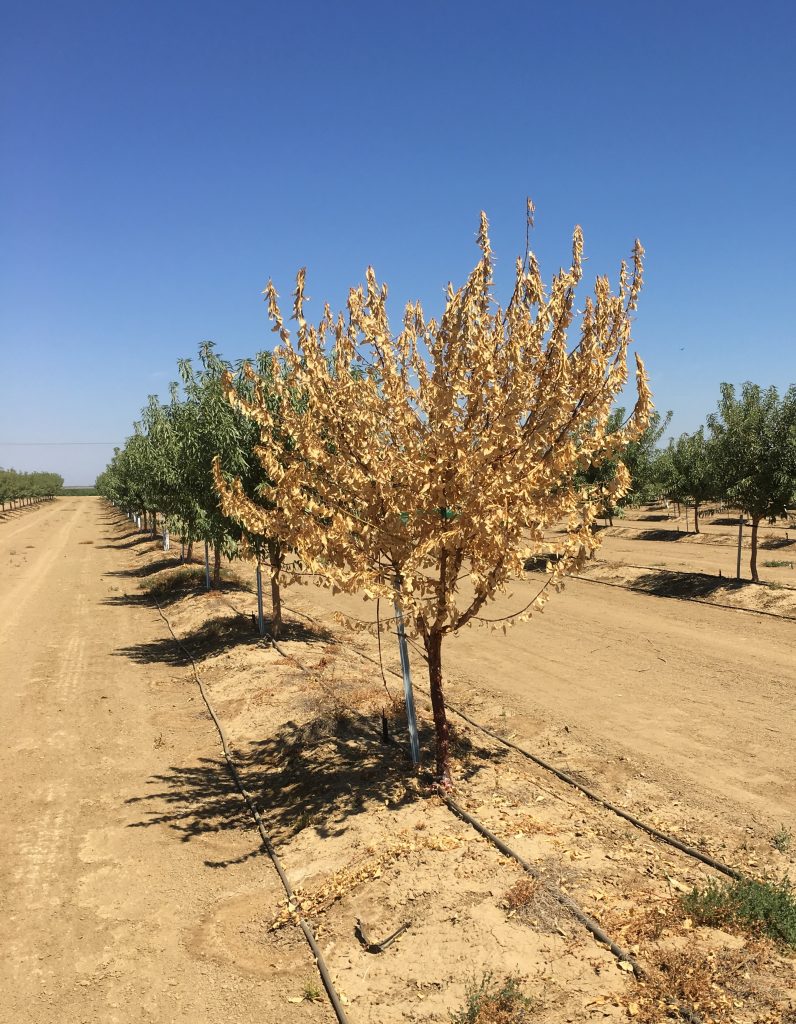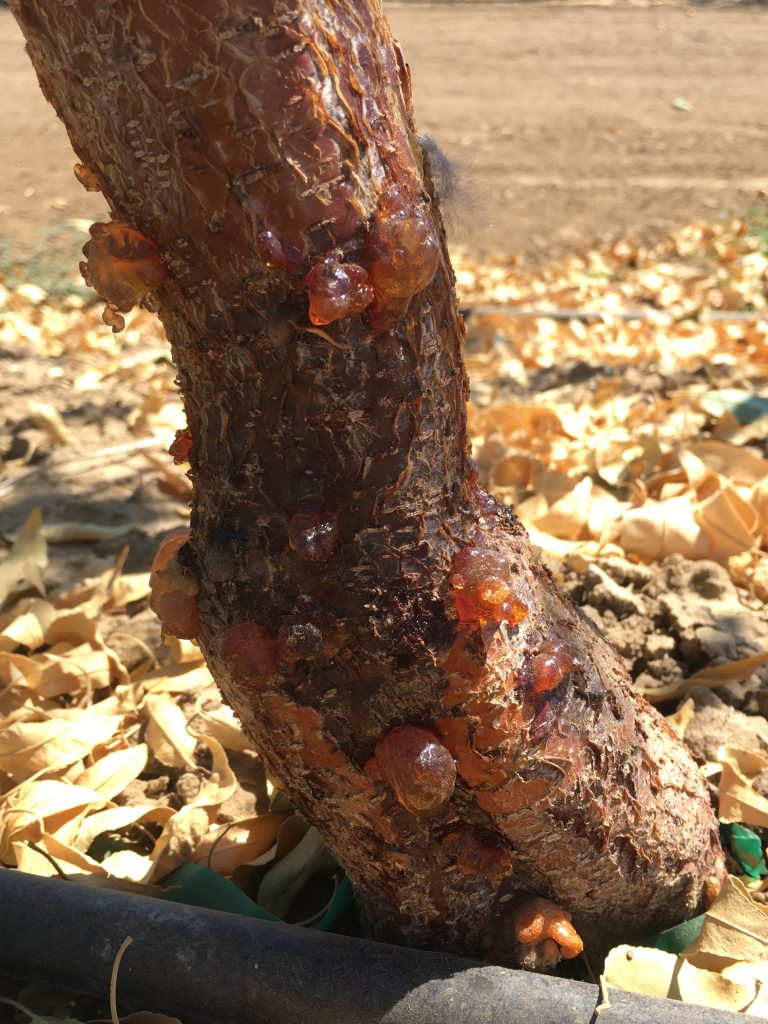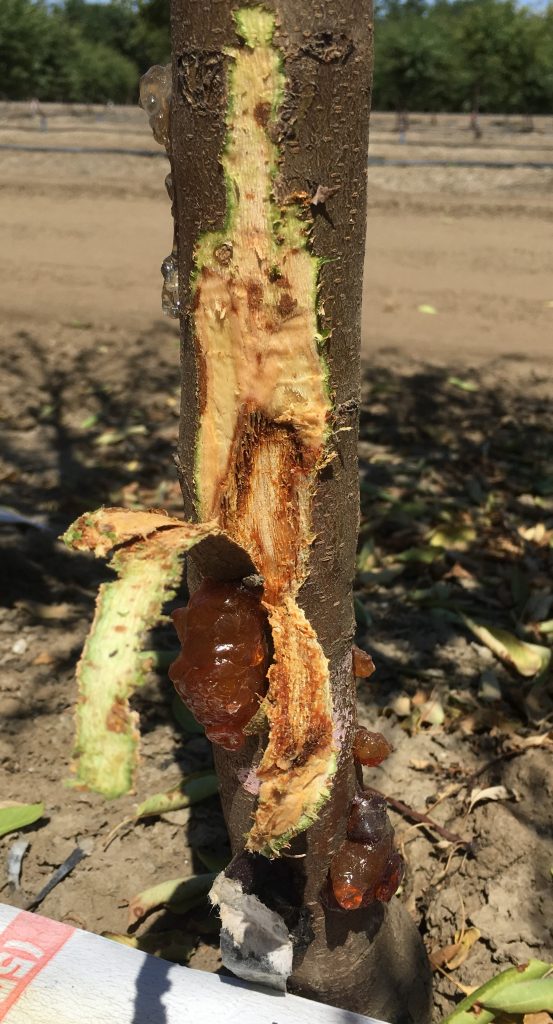As previously written (2009 article and 2015 article), Phytophthora is a plant pathogen of almond trees. This fungal-like water mold is common throughout the various almond growing regions of the world, with 6* or more known species causing disease. When conditions are conducive for infection, the pathogen directly invades plant tissues at the crown or roots, leading to loss of nutrient and water uptake, causing tree decline and eventual death. The rate of infection and tree loss depends on the inoculum present, the choice of rootstock, environmental conditions, and cultural practices that may favor disease.

Phytophthora inoculum can be endemic to the orchard area or introduced through a variety of ways. Low levels of Phytophthora probably exist in most soils, but typically are not at the levels or location to cause infection unless there are prolonged conditions favoring disease. Generally, introduction of inoculum into the area of close proximity to the plant is most likely responsible for infections and tree death. This includes the crown or base of the tree where the pathogen infects the plant just below the surface of the soil. These types of infections are most common and can lead to rapid tree loss. Root infections, which occur when soils are saturated with water, lead to a gradual decline. Finally, aerial Phytophthora happens when spores are deposited on limbs or in crotches of the trees through dust or flooding, followed by wet conditions (e.g. rain).
Surface water is believed to be the major contributor of Phytophthora inoculum in perennial nut orchards. Surveys have found several species of pathogenic Phytophthora in high elevation, upstream waterways of the major rivers in California. Due to the ability of the pathogen to survive in water, this pathogen is probably found in all surface water used to irrigate trees worldwide. This inoculum is able to move through the filtration systems due to size and is unaffected by current affordable and plant safe water treatments. Therefore, it is generally best to assume that Phytophthora is present in all orchards. As such, disease management should focus on rootstock selection and orchard practices that reduce disease.

Phytophthora infection rates are strongly influenced by the presence of water and excessive moisture. Saturated soils provide the ability for the spore to “swim” to the point of infection. This soil condition also stresses the plant, making it more susceptible to infection. Even though tree decline becomes apparent in warmer temperatures, infection rates are higher during the spring when the soil is cool, damp and the plant is active. Caution should be used when irrigating – do not apply water if adequate soil moisture is present.
Rootstock selection is one of the best ways to reduce disease within an orchard. Different rootstocks have varying genetic tolerances to disease. When selecting a rootstock, the risk of Phytophthora should be considered as well as other horticultural characteristics. With almond rootstocks, generally, plum parentage rootstocks (e.g. RootPacR, Marianna 2624, Krymsk-86) are the most resistant to infection while almond rootstocks (e.g. seedling rootstock) are most susceptible. Peach rootstocks, such as Nemaguard and Lovell, generally show moderate resistance while providing more tree vigor than plum parentage. Peach-almond hybrids (GF677, Hansen 536, Garnem and others) are highly susceptible to infections. Finally, complex hybrids such as Viking and Atlas have resistance levels similar to peach rootstocks.

Other practices can reduce the occurrence of disease within an orchard. Trees should be planted on a berm or mound so water can drain away from the crown of the tree. Infiltration rates should be maintained through the use of either soil amendments, reduced application rates, or larger irrigation patterns. Drip hoses should not be placed at the base of a tree to reduce soil saturation at the crown. Proper drainage should be installed to reduce saturated soils in low-lying areas. Finally, tree cartons or wraps should be removed after the first year to prevent aerial infections of the trunk, as debris and spores can collect in these areas and infect during rain events.
Although rootstock selection and cultural control practices are ideal in reducing disease occurrence, there are also some chemical control methods. Mefenoxam is a fungicide that can directly kill the pathogen, reducing the inocoulum load. This product must come into contact with the pathogen and reinfestation of the treated should be prevented. Potassium phosphite and fosetyl-aluminum applied as a foliar spray can reduce disease severity by increasing the tree’s defenses. These products increase the chance of compartmentalizing the disease, allowing for recovery. Soil applications of these products can also occur but generally do not show the same effect as a foliar treatment. Lastly, there is an increasing number of biological products that can reduce the occurrence of disease by either antagonism or plant protection. Due to the potential of limited capacity of these products, for the time being, it is best to use them in combination with other chemical control methods.
Disclaimer: Mentioning of any active ingredients is not an endorsement or recommendation. All chemicals must be applied following the chemical label, local and federal regulations. Please check with your pest control adviser to confirm rates and site-specific restrictions. The author is not liable for any damage from use or misuse.
*Phytophthora species of almond: P. cactorum, P. megasperma, and P. cinnamomi (root and crown pathogens), P. citricola (scion, aerial infections), and P. syringae and P. niederhauserii (links with nursery infections).
Materials referenced:
Browne, G. 2017. Resistance to Phytophthora species among rootstocks for cultivated Prunus species. Hortscience. Vol 52:11 1471-1476.
Browne G.T., Beede R.H. and Schmidt L.S. 2012. Irrigation water relation to the health of deciduous fruit and nut crops. In: C. Hong and G. Moorman (eds.). Biology detection and management of plant pathogens in irrigation water. APS Press St. Paul MN
Browne G.T. andBecherer H.E. 2000. Relative resistance to Phytophthora spp. among some rootstocks for almond. Phytopathology 90:S10
Schmidt L.S., Bhat R.G., Kluepfel D.A., and Browne G.T. 2012. Resistance to Phytophthora in new rootstocks for almond and stone fruitsPhytopathology102S4.106abstr.)


Steve Huffman
September 29, 2019Thank you David!
This information is very helpful.
You are much appreciated!
Steve Huffman
David Doll
October 2, 2019You are welcome, Steve. Glad you found the article useful.
David
Jake Miller
October 2, 2019Thank you for the really great information. Please keep me in the loop on any news in the almond field.
David Doll
October 2, 2019Glad you enjoyed the article, Jake.
Take care – David
Shannon Koehn
November 18, 2019Any thoughts on farming almonds in north western Az. And what to look out for as far as disease and soil problems.
Thank you
David Doll
December 7, 2019No, without knowing any specifics, I cant really comment. Northwestern Arizona is a large area. I would want to collect weather data to determine risk of frost (January through April) and winter chill accumulation, check water availability, and be aware of the distance to local processing in this situation.
David
Randy Reitz
January 6, 2020Thanks avid for the update. I found it useful. We have been applying potassium phosphite, which has definitely helped. Can you give us names of some of the biological products mentioned?
David Doll
January 29, 2020Randy,
There seems to be some variability across the biological products within the literature across plants. Some of it seems crop or site specific. Specifically to almonds, there have been no clear-cut results. Within other crops, suppression of disease does seem to occur with products that contain Bacillus species. Within avocados, Pseudomonas species seem to be correlated with suppressed disease.
I have included the use of biological based products as an alternative as the evidence does suggest that it is possible. I would, however, be skeptical of commercialized results and try on a limited basis.
David